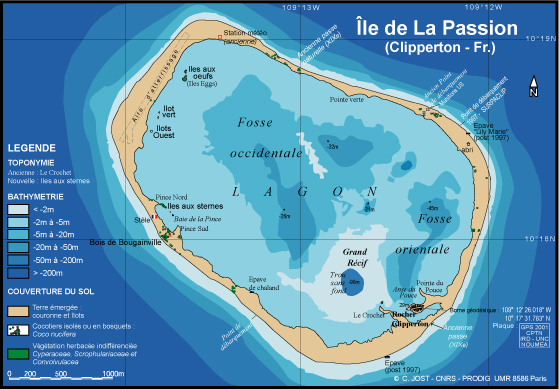Even if I was inclined to delete unpopulated "countries" from my list whenever I get to them, I think I would have left Clipperton Island. It's way too cool. I just couldn't pass up the opportunity to write about Clipperton Island.

Clipperton Island is actually an atoll, which is a relatively narrow ring of coral surrounding a lagoon. It is located in the Pacific Ocean, west of Costa Rica and southwest of Mexico and has a total land mass of approximately 3 1/2 square miles. Depending on which source you ask, the lagoon is either just really dirty or literally poisonous. The only vegetation on the island is some course, "spiny" grass, a creeping plant and a few stands of coconut trees. Besides the seabirds, the only animals there are these little orange crabs which look really harmless until they start swarming anything and everything that is potentially be food. Including people.
For some incredibly stupid reason which I fail to understand, during the past 300 years several countries have actually laid claim to this godforsaken place. Why, I don't know. Countries just love to lay claim to places, no matter how useless and godforsaken they are.
 |
| But it kind of looks like a tropical paradise ... |
So what makes this place so cool that I couldn't pass it up? Well for a start, it was named after pirate John Clipperton, who supposedly (though no one really knows for sure) used it as a base for raids on passing ships. But if that wasn't enough, it was also the setting for an incredible story that sounds like it was made up by a bunch of Hollywood scriptwriters.
Back in the early 1900s, a mining settlement was established on Clipperton Island. They were mining guano, in case you're interested. You know what that is, right? It's bird poop. Anyway about 100 men, women and children were established there, and every two months a supply ship from Mexico brought food and other essentials. Then the Mexican revolution happened, and after that the supply ships stopped coming. Eventually, all the men except one died of scurvy, or were possibly eaten by the crabs. The one who was left—lighthouse keeper Victoriano Álvarez—declared himself king and then embarked on a months-long reign of terror against the 15 women and children who remained, enslaving, raping and murdering many of them, until he was finally killed by one of his would-be victims. Shortly after that, the handful of remaining women and children were rescued by a US Navy ship.
As jaw-dropping as this story is, it didn't actually help me in my search for Travel by Stove material. For that, I had to move on to a later story: the wreck of the MV Monarch. The Monarch was a tuna clipper that sank near the island in 1962. Nine crewmen from that ship were stranded on Clipperton for 23 days, during which time they survived on coconuts, some potatoes and onions they managed to salvage from their sinking vessel and fish they caught off the island's reef. Hey! That sounds like a chowder. Here's the recipe:
Castaway Chowder
- 1 lb ahi tuna, cut into bite-sized pieces
- 1 lb russet potatoes
- 1 onion, chopped
- 1 can coconut milk
- Water to cover
- Salt to taste
Salt I took some liberties with. People do cook with seawater (in fact seawater cooking is popular for lobster cook-offs and other big seafood to-dos in many coastal parts of the US), so I figured the crewmen could have flavored their chowder by using seawater as a base. Now, I don't really know how salty the finished product would have been, so I just salted mine until it tasted good.
The directions for this chowder are simple, because let's face it, the castaways were probably too busy finding food to care much about how it was prepared. I didn't peel the potatoes, because anyone facing a hunger situation would be crazy to get rid of all those extra nutrients.
First, put the onions in a pot and add a little salt. I picked up this trick many years ago from a book called Indian Cooking Without Fat
Anyway, when cooking onions this way you do have to keep stirring. Once they've turned translucent, add the tuna, potatoes and coconut milk. Pour in just enough water to cover.
Bring to a boil, then reduce heat and simmer until the potatoes are tender, adding more water as necessary. Use a potato masher to mash up some (but not all) of the potatoes, so your chowder will have a little body to it. Salt to taste.
I served my castaway chowder with freshly ground black pepper and bread. Which obviously are two things the crewmen wouldn't have had, but you know, I didn't want to torture my poor husband too much.
This simple chowder was actually surprisingly good. If I was a castaway I would have actually been drooling over it, though in our land of abundance it was simply a nice meal. The coconut milk made for a tasty, if not particularly unusual combination with the fish. Plus it was easy, which gave it extra points for me because easy is something Travel by Stove meals almost never are.
So how about that, it's almost like I got a vacation on Clipperton Island.
Next week: Cocos-Keeling Islands
For a printable version of this week's recipe:















I LOVE your blog! It's amazing. I will definitely be trying lots of the recipes on here.
ReplyDeleteHi Fiona, thanks for the compliment! Let me know when/if you try some of the recipes. I'd love to know what you thought. :)
ReplyDelete